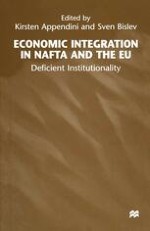1999 | OriginalPaper | Buchkapitel
Successful Integration and Economic Distress: The New Dual Economy — the Case of Mexico in NAFTA
verfasst von : Sima Motamen-Samadian, Etelberto Ortiz Cruz
Erschienen in: Economic Integration in NAFTA and the EU
Verlag: Palgrave Macmillan UK
Enthalten in: Professional Book Archive
Aktivieren Sie unsere intelligente Suche, um passende Fachinhalte oder Patente zu finden.
Wählen Sie Textabschnitte aus um mit Künstlicher Intelligenz passenden Patente zu finden. powered by
Markieren Sie Textabschnitte, um KI-gestützt weitere passende Inhalte zu finden. powered by
1994 was the first year of Mexican integration in the North American Free Trade Agreement (NAFTA), and the start of a period when Mexico was supposed to benefit from the further opening up of its economy. It turned out, however, to be one of the most turbulent years in the recent history of the Mexican economy. The substantial outflow of capital which began in the second quarter of 1994, ultimately led to a significant loss of foreign exchange reserves, abandonment of the pegged exchange rate regime, and a 71 per cent real depreciation of the peso. The question frequently raised was, what went wrong with the Mexican economy? After all, it appeared that the programmes for stabilization and structural change that were implemented by the Mexican authorities from the mid-1980s were rather successful in reducing the rate of inflation and improving the efficiency of Mexican producers. Above all, the core of the new programmes was from the begining oriented towards creating a new structural relationship with the rest of the world: essentially a new pattern of integration.
